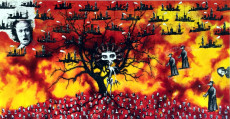
Dufy : to twist

Is it possible to judge an artist's work as both bad and great?
Raoul Dufy's, for example. There is clearly something to eat and drink, in our opinion, in the works of Dufy shown in Connaissances des Arts in the article it devotes to the most Parisian of Le Havre painters this month. What to think of these paintings, screens or armchairs "decorated" with Eiffel Towers, Pantéon and flowers? And totally deserted. But joyful nonetheless, thanks to a palette that is both tender and lively.
You get the feeling that the artist has stuck fragments of his colourful world wherever he can. If we were to do the same thing today, we would be on the verge of an overdose. It's worse than too much. Too much. But, at the time when Dufy was a party buddy of Jean Cocteau, excess in everything was a form of festive hygiene. We were happy to go and see shows where "nothing would happen". People danced with papier-mâché animal masks, painted the sets and signed them Dufy.
This explains it. But it does not justify it in any way. The artists' public is not their contemporaries. To be close to genius, one must address the future as well. This is how art offers us mirrors of the future. By seeking to inscribe eternity in the moment of the work. And in this respect, frankly, who would want a Dufy armchair to sit in their living room amidst design furniture by Putmann, Ito or Bouroullec?
It was not thanks to his sometimes classy but often naive and stuffy kitsch furniture decorations that Raoul Dufy had any chance of arriving on time for his appointment with art history. Unless the critics of the future put Castelbajac on the same level as Picasso.
But an artist's work can be judged as both bad and great. And the strange thing about Dufy is that he finally excels in the ultimate test: painting. The subject matter and technique must be meticulously chiselled because there are many candidates for eternal fame here. The stakes are different from those of choosing seats and backrests flanked by legs and armrests as the frame for his paintings. One does not sit on art. Except perhaps for the thieves in Cattelan's solid gold toilets.
Where we rediscover that Dufy was above all a painter. And a great painter at that, with a discreet but profound modernity. The most astonishing thing is that Dufy uses the same ingredients in his canvases between Matisse and Cocteau that he industrializes in the textile patterns produced in his "Petite Usine". A Factory before its time.
The sunny pastel palette made in Dufy, deserted places and then Paris, Paris, Paris are mainly found on canvas. The difference with the furniture motifs made in Pigalle? Paris is not exhibited here, it is not the world capital of tourism. The City of Light is reduced to Hausmannian facades that are barely sketched out and yet recognizable among a thousand. Even seen between two doors, through a window, but in no way put on display.
The deserted place depicted is no longer the city but the painter's lair, as in the painting entitled L'Atelier de l'impasse Guelma. The colourful world of Cocteau's friend has become the void in which the work is created. The paintings placed in abyme in the paintings of this more intimate period show the modernity through which the painter seeks a path to eternity. More than the noise he liked to make, it is Dufy's silence that we still hear today.
Illustration: Raoul Dufy - The Studio at Impasse Guelma - 1877





































































